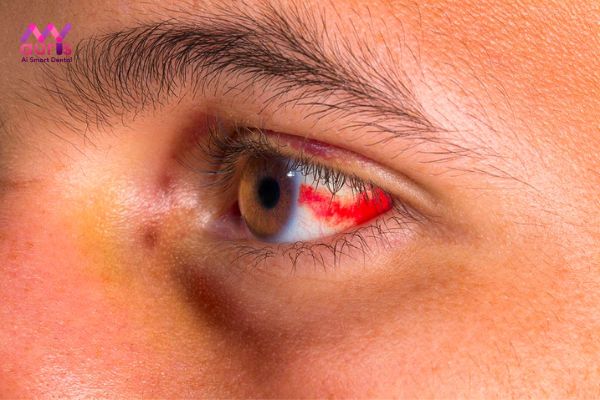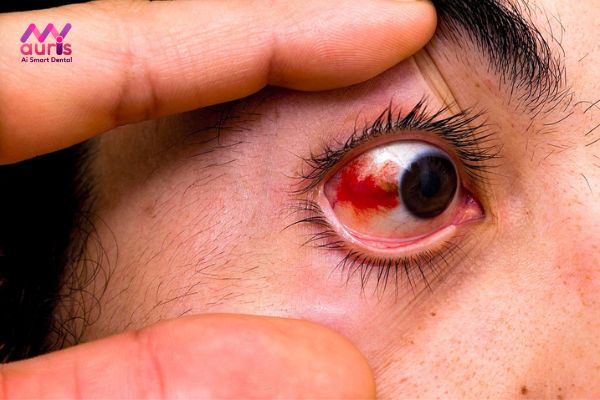Eye bleeding occurs when a small blood vessel bursts right under the white of the eye. You won’t be able to recognize this expression until you look in the mirror and see the whites of your eyes are bright red. Eye bleeding is not a rare phenomenon, however this phenomenon sometimes causes fear for patients because it will affect vision and eye health.
Find out what eye bleeding is?
Eye bleeding, also known as ocular hemorrhage, is the phenomenon of blood flowing inside the anterior chamber of the eye. Unlike skin wounds, when blood in the eye flows out of the blood vessel, it will not form a stream or drip to the outside, but will creep into the space between the conjunctiva and sclera, forming a streak like an oil slick. Therefore, when observed with the naked eye, you can see red spots in the eye or the entire white of the eye will be red.
There will be no signs that can be considered a warning sign for this condition, and eye bleeding will also not cause any pain or discomfort to the patient. There are only a few cases where the patient will feel their eyes are a little stuck or a little stinging. The rest of the patients will discover it through accidentally looking in the mirror and seeing red eyes or someone telling them.

Classification of types of bleeding eyes
Conjunctival hemorrhage
The conjunctiva is the transparent membrane at the top, covering the entire white part of the eye and on the conjunctiva, there are many nerve fibers and very small blood vessels that cannot be seen with the naked eye. When a blood vessel cracks or bursts, it results in a hematoma in the white of the membrane called a conjunctival hemorrhage. This type usually does not cause any pain to the patient and also does not affect vision.

Anterior chamber hemorrhage
Here is the phenomenon of blood accumulating between the cornea and the iris. This condition occurs when the patient experiences an injury that causes the iris tomust be damaged or torn. For conjunctival hemorrhage that does not cause pain, anterior chamber hemorrhage will cause slight pain to the patient. Although this type is less common, the condition is quite serious. People with sickle cell anemia should pay special attention. It can cause total loss of vision if not treated promptly.

Deeper types of bleeding
These types of symptoms often show no visible bleeding. eyes on the surface, but sometimes will cause red eyes. Deeper types of hemorrhage include: Vitreous hemorrhage, subretinal hemorrhage and submacular hemorrhage.
Causes of eye bleeding
The cause of eye hemorrhage is not always clear, it can originate from a few of the following reasons:
- During daily activities such as lifting heavy objects or experiencing stress problems, high blood pressure, allergies, using contact lenses, sneezing, coughing, etc., blood vessels in the eyes can also break.
- Patients rub or scratch their eyes too hard, or are stabbed by sharp objects in their eyes, have accidents, fall, etc., causing injuries to the eyes, face or head, which are also causes of eye bleeding
- Patients taking drugs such as dabigatran, rivaroxaban, warfarin, and heparin that prevent blood clots will have an increased risk of eye bleeding. In addition, using some dietary supplements or over-the-counter NSAIDs also causes blood thinning. Patients need to immediately notify their doctor if they use the following medications: naproxen, aspirin, ibuprofen, evening primrose, saw palmetto, garlic, etc.
- In the treatment of some viral infections, interferon immunotherapy is also associated with eye bleeding
- Some other causes: Abnormal blood vessels appear in the iris, complications after eye surgery, blood clotting, eye infections,…
In addition, eye bleeding or eye hemorrhage can also originate from some eye diseases such as: Retinal tears macular degeneration, arteriosclerosis, age-related macular degeneration, multiple myeloma, Terson syndrome, conjunctival prolapse, infection,…
Is eye bleeding a worrying phenomenon?
Eye bleeding can originate from injuries or diseases. Depending on the location of eye bleeding, this condition can be considered harmless or serious, causing complications and permanent damage to vision if not treated. treatment.
To minimize potential complications such as: Impaired vision, loss of vision or blindness, glaucoma, chronic inflammation and scarring, after being diagnosed with the causes of eye bleeding, the patient needs to take it seriously and fully comply with the doctor’s treatment plan.
It is impossible to predict the complications of the disease, which can range from having no effect at all to the patient being at risk of permanent vision loss. This will depend greatly on the diagnosed cause and the doctor’s treatment method, so it is important above all that the patient needs to have his or her condition detected quickly and promptly.
In general, eye bleeding is not a life-threatening condition, but it can potentially lead to many serious complications if not treated. Patients need to see a doctor early if you experience any signs of discomfort. In addition, you need to have a regular vision exam every 6 months to protect your eye health.
Treatment methods
Diagnosis of eye bleeding
During the diagnosis process, the doctor will look at the eye and check for signs, looking for the location of eye bleeding. The patient will then be asked to take measures such as:
- Use eye drops to dilate the eye. death
- Conduct a CT scan to look for injuries around the eyes
- Check blood pressure
- Blood tests to detect potential conditions
- An ultrasound to examine the inside and back of the eye
Treatment of eye bleeding
The doctor will determine whether the patient needs treatment for eye bleeding by determining the cause of the disease. Eye bleeding is usually not too serious if the patient’s vision is still intact Normal and no signs of pain, only bleeding in a small part of the albumen, the phenomenon will disappear on its own within about 2 to 3 weeks. But it should be noted that treatment will be necessary if the cause originates from underlying diseases
For the remaining types of eye bleeding, the treatment method is as follows:
- Use eye drops to control swelling, pain, inflammation, etc. The doctor will prescribe eye drops depending on Depending on the condition, the most common cause of eye bleeding can be artificial tears, antibiotics, antiviral drugs, etc.
- Performing lacrimal gland surgery
- Surgery laser
- Eye surgery to drain blood
In addition, patients need to know care measures to speed up the treatment process at home:
- Do not wear contact lenses without your doctor’s permission
- Check your blood pressure regularly with a home monitor
- Get enough rest, don’t do too much physical activity
- Use an eye patch or wear a shield during treatment
- Use eye drops and other medications as prescribed by your doctor
Yen Nhi





